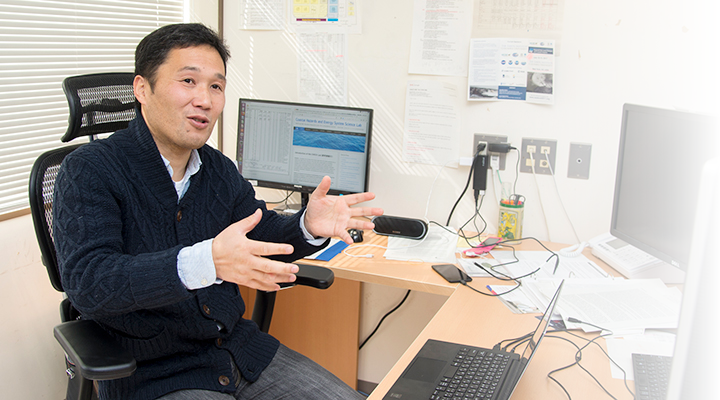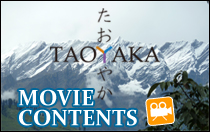
INTERVIEW
Researching coastal hazards and renewable energy resources
Enhance our understanding of
global warming,
natural hazards and energy issues,
and their relationships for safe, stable,
and sustainable development.
Social Implementation Course
Graduate School of Advanced Science and Engineering
Assoc. Prof. Han Soo Lee
Researching coastal hazards and renewable energy resources
The world around us is tied together with waves, which provide us various insights and possibilities

Professor Lee, who specializes in coastal and ocean engineering, tells us that he was led into research by an interest in the waves he learnt about in his high-school physics classes. In coastal and ocean engineering, he researches the wave forces to be account when designing coastal structures such as ports, breakwaters and so on. In particular, he focuses on estimating how high wind waves, namely storm waves and storm surges, will be either theoretically, experimentally or numerically.
“One consensus made across our research group is that it’s almost certain that if ocean temperatures increase alongside global warming, there will be a greater likelihood of much frequent occurrence of super-typhoons, and therefore more likelihood of higher storm waves.”
Professor Lee’s researches estimate the waves and their effects in coastal areas, and the results of the researches can be applied in the development of technologies for disaster prevention and mitigation, and the establishment of forecasting and warning systems.
“I somehow think the civil engineering is one of the most pioneering fields in engineering and science. Moreover, coastal engineering in civil engineering fields is thought to be particularly difficult, and traditionally not many students pursue this discipline for their careers. It involves (salty) water, which is one of the hardest medium in mechanics, and it has to incorporate the various effects from atmospheric conditions, river flows, oceans, and human activities in coastal areas. Yes, it’s extremely difficult, and that’s exactly why I find it to be such an attractive and interesting field,” said Professor Lee.

Recently, Professor Lee has expanded his researches to studying energy, and is now eagerly engaged in quantitative assessment of renewable energy resources and management such as (offshore) wind power, solar power, and wave power in particular.
Looking at the future of his research, he tells us, “I feel that the key of acceleration of global warming and to decelerate the warming is quite probably linked to the oceans.”
Learn the science background and mechanisms behind the global warming

Professor Lee’s role in the Taoyaka Program is lecturing the Energy Science and Technology. In this course, he gives lectures on renewable energy, such as solar power, wind power, ocean power and so on, and conducts 2-3 on-site field trips. Previous destinations of field trips include the Nukui Dam, a solar power generating facility, and the Saijō Sewage Processing Center, which has facilities of small-scale hydropower generation using the treated water before discharging. Finally, the course ends with student presentations and discussions.
“There is a lot of technical material: starting mainly with explanations of technical systems concerning renewable energy, how to use them in practical application, how to process wastes, and so forth. So, the course seems to be difficult. However, the contents of the lectures are brought together in the end to illustrate the relationships among economic development, energy, and environment in the context of global warming and to discuss what could be done by ourselves for building low-carbon society. Many students from non-scientific fields take the class, and definitely learn and fine the contents very helpful.

One factor behind Professor Lee’s words here is his hope that, through these lectures, students will become more aware of the environmental issues around us.
Many of those taking the course are foreign students mostly from developing countries in Asia and Africa, and they will become high-level decision-makers, such as civil servants and academic leaders, after returning to their home countries. Therefore, it makes this lecture much important and valuable.
“Without an understanding of the scientific and engineering contexts, incorrect decisions could be made. My hope is that the course will make this less likely.”
Professor Lee also tells us, “Many people, for example around 7 or 8 people out of 10, know not much about the process and scientific basis behind global warming. The class will help us to discuss the question of what we can do and enable us to develop our awareness.” He said that he notifies the change in his students after taking the course: “If we can gain more awareness in our behavior, our work, and our daily lives, and then, it is already meaningful as itself.”
An interdisciplinary program which motivates students and further requires their abilities in major subject

Professor Lee is involved as a mentor in the Taoyaka Program, which he praises for its clear and understandable mission and objectives, the program attracts students who understand this purpose, and is proven to be successful.
He also encourages an interdisciplinary approach in research based upon his own experience.
“I started working for Hiroshima University in 2007 and became an associate professor in April 2016, during the period I spent two years at another university. One reason for this was that I felt a sort of barrier in conversations with people from other fields, and I found myself wanting to return to my original major subject.
But my time at IDEC wasn’t all for nothing, and I did feel some change in my thought. I truly realized that solving environmental problems, particularly in developing countries, would be difficult using engineering and scientific approaches alone, and I think much can be done through real multi-disciplinary approaches as in IDEC. This is one of the reasons why I return to IDEC.” He also hopes that students, whilst of course working on their own particular expertise, would try to widen their perspectives a little outside of their major subject fields.

“By participating in an on-site field project within the interdisciplinary program, then you’re able to see what you’ve learnt from your major subject being useful in practical situation. Consequently, you will find yourself being much motivated and engaged in what you are doing with much meanings. The Taoyaka Program offers a rare and valuable opportunity to hear various opinions and discussions across disciplines. For any student wanting to put their major subject knowledge to greater use and to do something to address practical issues, I really think joining this program would be of great benefit.”
![]()
Han Soo Lee Associate Professor
Social Implementation Course
Graduate School of Advanced Science and Engineering, Transdisciplinary Science and Engineering Program
2020.4.1-: Associate Professor, Graduate School of Advanced Science and Engineering, Hiroshima University
2016.4.1-2020.3.31: Associate Professor, Graduate School for International Development and Cooperation, Hiroshima University
2014.4.1-2016.3.31: Associate Professor, Department of Civil and Environmental Engineering, Saitama University
2012.1.1-2012.3.31: Visiting researcher, College of Marine Sciences, National Sun Yat-sen University, Taiwan
2010.4.1-2014.3.31: Assistant professor, Graduate School for International Development and Cooperation, Hiroshima University
2008.10.1-2010.3.31: Assistant professor (Special Appointment), Graduate School for International Development and Cooperation, Hiroshima University
2008.4.1-2008.9.30: Researcher, Graduate School for International Development and Cooperation, Hiroshima University
2007.10.22-2008.3.31: COE Researcher, Graduate School for International Development and Cooperation, Hiroshima University





